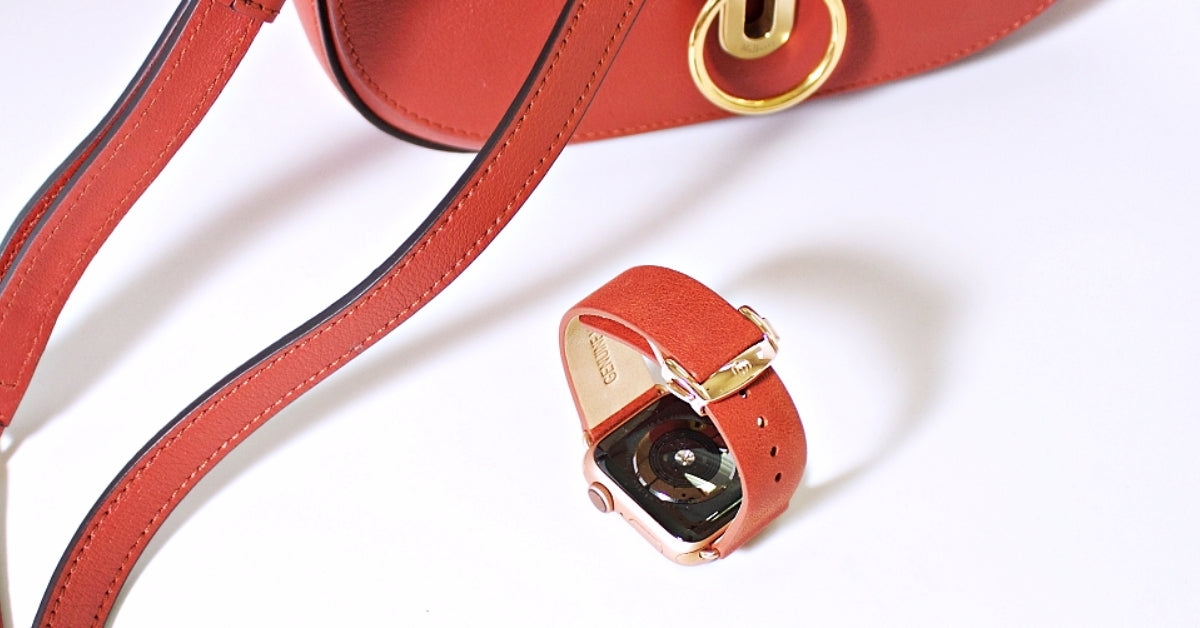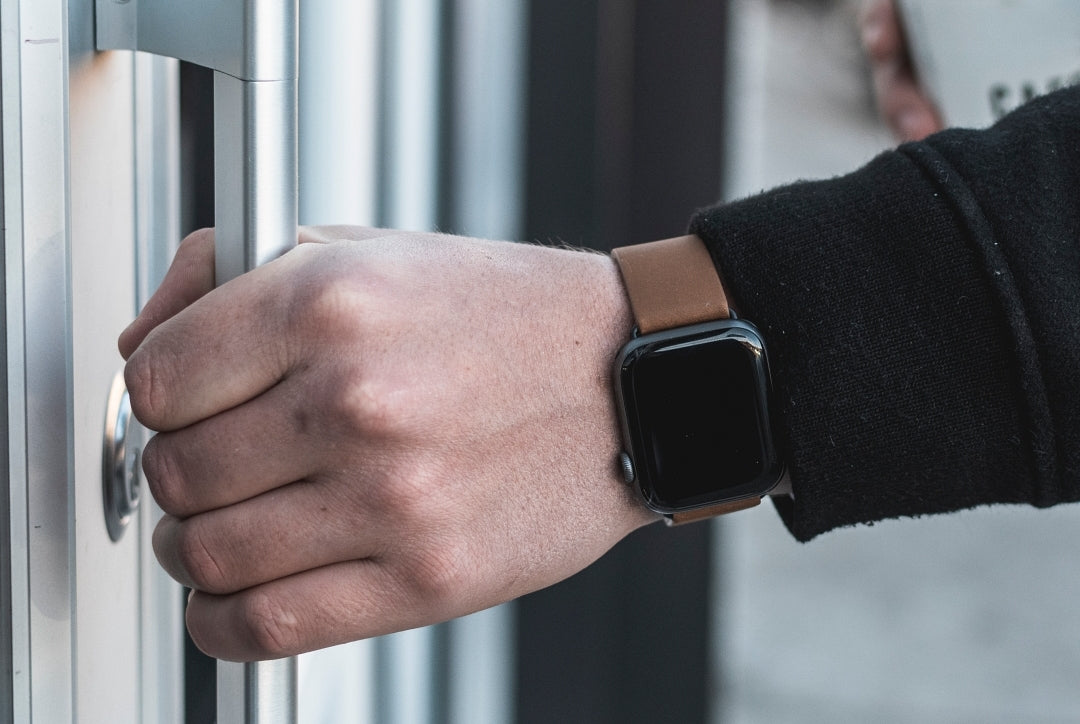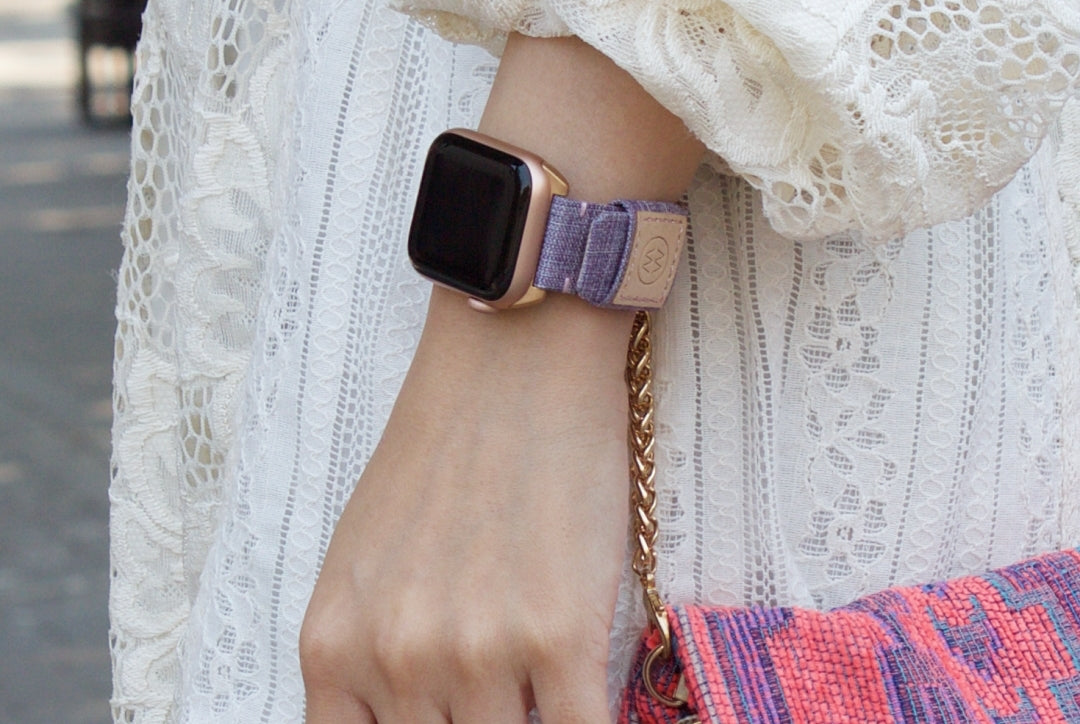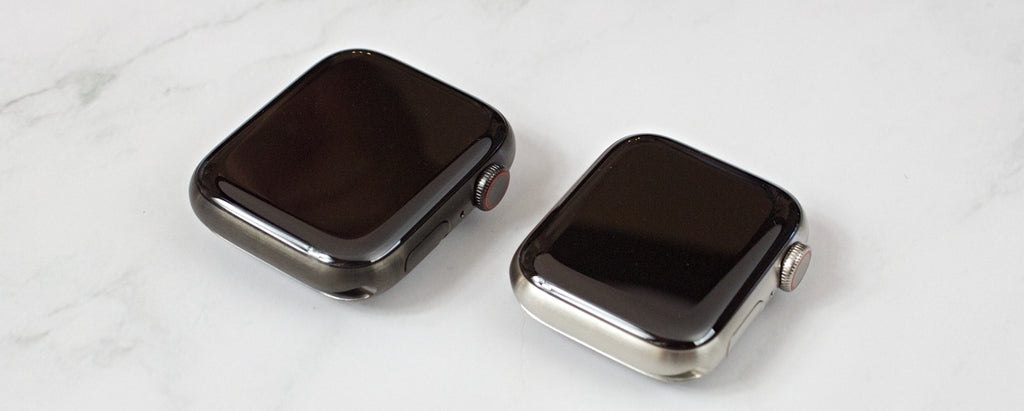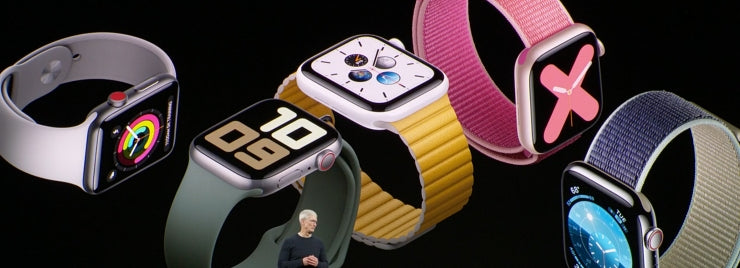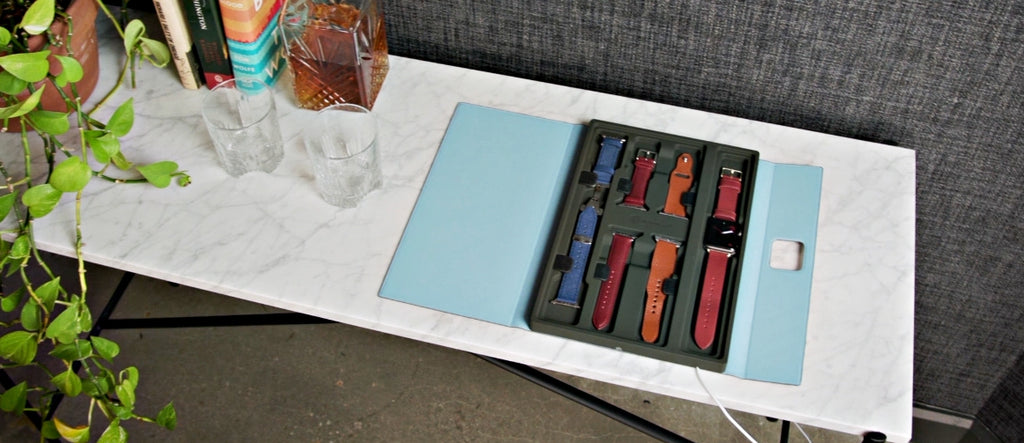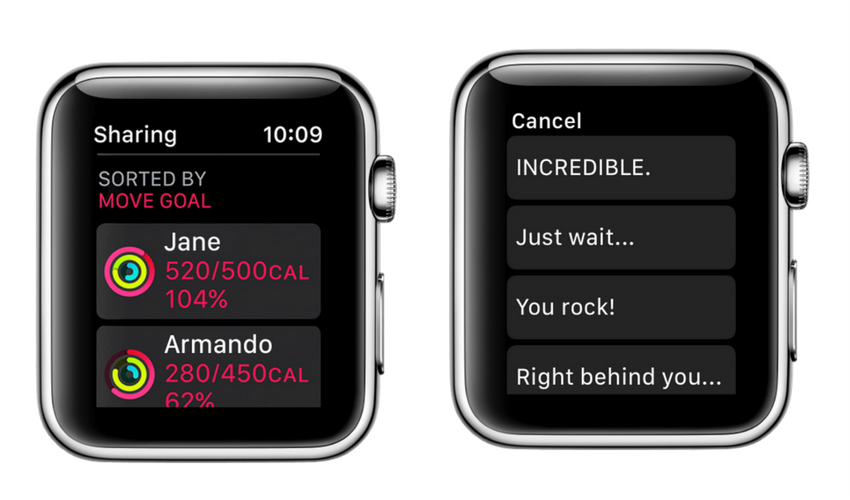
Make Exercise Social with The Apple Watch
Competition, Sharing, Gamification Turns Activity App into Fun
Both anecdotal and scientific research have shown that social connections have increased activity due to tracking, comparing, and competing. Perhaps in its simplest form, it just means peer pressure -- whether you’re sharing exercise data with friends, your spouse, extended family, or your children, when you have other people getting involved and comparing, it simply gives greater incentive to getting on the exercise routine.
With watchOS 3, the Apple Watch (paired with an iPhone running iOS 10) allows you to share your Activity rings with up to 25 people. Similarly, you can check in on their status at any time. This back and forth allows you to view each other’s progress, get updates on status, and encourage working out. For many people, having a fitness buddy helps them maintain their routines and motivation. Through the power of modern wearable technology and data networks, this can now be had even if your friend is across the ocean.

Photo credit: Apple
How to Set Up Activity Sharing on Your Apple Watch
Let’s break down the specifics of how to get this to work, as well as setting your own goals.
First, you’re going to need to create your network of Activity contacts.
- Open up the Activity app on your iPhone, go to Sharing > Get Started, and you’ll be able to type in up to 25 contacts.
- Each contact must be using an Apple Watch running WatchOS 3 in order to share and compare data, so this won’t work if their iPhone is synced with a non-Apple wearable.
- Once you hit Send, they’ll get an invitation to share Activity data.
What Exactly Gets Shared with Your Contacts?
You’ll be able to check in on their general status at any time by opening the Activity app on your Apple Watch and swiping left. You’ll get an at-a-glance view of their Activity ring and current status, so you’ll know how they’re going towards their goals and how it compares with your own activity. The Activity app gives you the ability to send a message to any of your contacts, so whether your method of encouragement is praise or taunting (we all have friends like that, and hey, sometimes it works), it’s easy to offer a quick take on their workout situation.

The Apple Watch will also provide automatic notifications to keep you up to date on their activity. You’ll receive automatic notifications when your contacts meet three of their activity goals, finish a workout, or earn Activity Achievements -- all of which offer bragging rights. At the same time, if someone’s being a little too obnoxious with their Achievements, you can mute a particular contact. You can also keep viewing others Activity status while hiding your own if you have a personal need to go dark for a little bit.
Setting Your Own Activity Goals
With the Activity app, a big part of what makes it effective is the ability to set up multiple goals. Setting goals has long been recognized as a key part of working out -- not only does it give you motivation for fulfilling targets, it also helps track your progress. The standard Activity goals displayed on the three colored rings are for calories burned, exercise, and standing. To change your goals, swipe left to get to the Activity rings, then tap and hold on the screen. This will bring up the option to change your Move (calories burned) goal, which can be adjusted using the digital crown.
Exercise is measured as vigorous movement monitored by elevation in heart rate. This is not necessarily tracked as a standalone goal. Instead, the ring on Activity can be lapped as many times over as you see fit. The standard exercise target is 30 minutes a day, which is what the Mayo Clinic targets for everyone from a general health perspective. Of course, you’re certainly encouraged to exercise more than that if you have the time and means to do so, and the Activity app will recognize that by lapping the ring several times over. Note that you can’t adjust an Activity target for exercise. Something a little more specific like that requires the Workout app to do that. Similarly, standing uses a standard count. The goal is to stand up at least twelve times a day for at least a minute.
Setting Your Watch for You
The accuracy of your calorie burning, exercise, and even standing can be increased by setting proper height/weight settings on your Apple Watch, as well as doing a general calibration (see these steps for calibrating your Apple Watch). Calibration and an accurate profile are an important part of generating accurate data, particularly if you’re sharing your data with others in a friendly or competitive way -- but particularly so if you’re going for that extra level of competition.
Fitness & Gamification
Competition through general activity sharing is a good foundation for using social activity as workout motivation. However, gamification -- that is, turning the process of working out into a game -- is an idea that has integrated into exercise technology. With gamification, it’s possible to use game-style goals to push yourself further, then share this with people in order to create a friendly competition. In many cases, something like this isn't just fun -- it's necessary to keep people moving, despite easy access to wearable tech and the most ardent of New Year's Resolutions, most fitness wearables wind up unused after a while.
Scientific Studies and Working Out with Friends
This isn't just an idea based on anecdotal evidence. A recent study published in The Lancent Journal of Diabetes & Endocrinology showed just this: participants only kept up their regimen when incentives were provided (in this instance, actual cash). Once those incentives ran out, so did the exercise routine.
Another study published in JAMA showed something even more discouraging to the general wearable audience: that the users with tech actually failed to lose more weight than users without it. Study author John Jakicic thinks that part of this is a sense of false accomplishment, which leads to cheating -- that is, if you've got your goals, it's easy to convince yourself to eat junk food. There's the old joke about “I went to the gym so I earned my smoke and beer”; imagine that except with daily validation. Try as we might, people don't change that much.

The trick, then, is to keep it incentivized. Unlike the first study, regular cash flow probably won't be available (though one idea is to get a group together, pool cash into a monthly prize, and award it to the person that hits their Activity goals the most). Instead, gamification provides incentives that are fun, often free, and often a social experience.
Start Earning Achievements
One of the biggest ways Apple integrated gamification into the Apple Watch and the Activity app was the use of Achievements. If the word sounds familiar, it’s because it’s what Xbox uses for similar things -- in fact, the whole idea was born on the Xbox 360 as a means of completing goals for specific tasks on games, and the whole thing really took off once the Xbox userbase became connected and people were able to share their achievements. (Similarly, Playstation’s version are known as Trophies; we’re not sure why Apple decided to use the same term as Microsoft’s given the company’s long-standing rivalry).
Activity Achievements are awarded when you hit certain milestones, such as successfully completing a perfect week of daily standing goals or tripling your daily exercise goals. You’ll also get an achievement every time you hit a new personal record. There are 19 standard Activity achievements, and every time you acquire an Achievement, it will register as shared activity on your friends’ notifications.

Special Holiday Achievements
Apple has also patched in updates with seasonal Achievements for various challenges (you’ll get these as notifications). For example, on Thanksgiving, a special Achievement was made available for anyone who ran or walked a 5K -- this included the Achievement and a special iMessage sticker, both of which would be sent to friends via a notification.
Another example comes from the most recent New Year’s celebrations: Apple’s newest challenge was to have a perfect week in January as a form of New Year’s Resolution fulfilment. Being able to share these special Achievements and iMessage sticker ups the ante from a social aspect, and it keeps the gamification aspect of it fun and alive.
Working Out, Your iPhone, and Your Apple Watch
The second method of workout gamification comes when your Apple Watch is used in conjunction with apps on your iPhone. Just this past summer, we saw what this really could do for people thanks to the unexpected success of Pokemon Go.
2016 was the summer of Pokemon. That probably sounds a bit strange given that the franchise has been a children's staple since the mid-1990s -- and even then, it still mixed between cartoons, video games, and card games -- but the release of Pokemon Go for smartphones was a watershed moment in the technology industry.
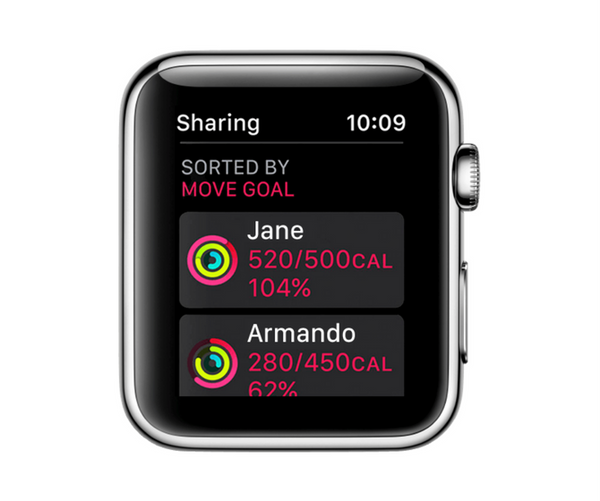
Photo credit: Apple
Plenty of apps had previously hit the market for working out, tracking via GPS, mapping, and other data that provides real time feedback on where the user is and how active the user has been. Much of the smartwatch craze has been centered around health and providing accurate data to take exercise to the next level. But Pokemon Go was the first to successfully combine the idea of getting outdoors, integrating a device's GPS, and providing an AR view to create digital targets. It was simple, fun, and could be played with friends in groups and teams. By loading Pokemon Go on an iPhone and using the health app on the Apple Watch, you could have plenty of AR outdoor fun (for all ages; many families noted that it was a great experience for them to share) while monitoring your distance traveled, heart rate, calories burned, etc. In short, playing Pokemon Go made it easy for Apple Watch users to hit their Activity goals.
Of course, Pokemon Go came and went, the summer trend is no longer taking over headlines and public consciousness like it did some months back. However, it marked a significant leap forward in mainstream penetration of an AR app. Fitness could be fun, even for those who traditionally hated outdoor activity.
Screen time is often seen as the enemy when it comes to fitness, but ironically, this type of technology is encouraging people to get out and about to do stuff. Let’s take a closer look at how something like this works in the smart ecosystem.
Creating Technology Feedback Loops
What really happens when you get your family to go out to hunt a virtual target, whether it’s a Pokemon or a publicly sourced geocache or another game developed by a commercial company? Your family may simply have the fun of getting outside, looking for the elusive target, and competing against one another -- exercising by at least walking, but perhaps even pushing it by using bikes or running. However, from a technology perspective, there are several feedback loops happening, creating a smart ecosystem that was simply impossible even a short decade ago.
Let’s say you and your family decide to go geochaching -- but to up the stakes, you make it competitive. So Mom takes their son Sam and Dad takes their daughter Sally. Both pairs have the same geocache target on the parents’ respective phones. To make it even more challenging, the geocache selected is on a public city location, and both pairs agree to start out from opposite sides of town. Mom and Dad both have Apple Watches to track their health vitals in sync with their iPhones.
Feedback Loop 1: The geocaching app pulls from a cloud database of the target’s coordinates. This is then synced up with the iPhone’s GPS, which can then connect to a map app to provide a walking distance from the target and a dynamic route to get there. This also syncs up with the Apple Watch’s map capabilities, which allow for easier check-ins on location for decision making on short cuts.
Feedback Loop 2: Since this is a race, the goal is speed. Each parent has the workout app on their respective Apple Watch, so to get things going, each pair rides bikes to get there. As each parent rides, their heart rates, speed, and distance traveled all monitored by the Apple Watch. Activity goals (30 minutes of exercise, etc.) are updated with notifications sent as each person achieves it.
Feedback Loop 3: Because of the competitive nature of the game, there’s gotta be some trash-talk involved. Through the family’s group chat session, gloating and taunting are sent back and forth, with notifications showing up on the Apple Watch for easy reading.
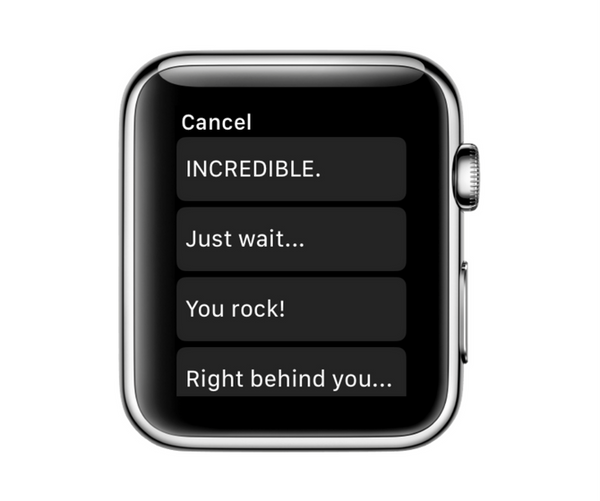
Photo credit: Apple
The End Result in a Connected World
A fun afternoon out as a family -- all while getting a good workout and Activity goals met, shared, and compared. Without modern smart technology, this simply wouldn’t be possible. It’s a simple example that shows the power of the connected world, and while it’s easy to stereotype smart tech as further isolating us, the truth is that it can easily bring us together and put us into the world, closer to nature.
Our Favorite Apps to Get Outside
You’ve synced up your Apple Watch to your iPhone, you’ve set your goals on your Activity app, and you’ve created your list of friends to stay in touch and compare results. Now, how are you going to stay motivated? We’ve already established that gamification is a leading method in keeping people to stick to their exercise goals. With the use of GPS-enabled apps, it’s easy to find additional iPhone apps to motivate you to get out there -- either competitively against friends or together as a team -- so that you hit your Activity goals...and have fun. Here are our recommendations:
Gaming: Pokemon Go is the most well-known AR app for getting outside. This platform uses a database of targets and spreads them in real-world locations. By syncing up to your iPhone’s GPS, it gives you a path to find the target, capture it (via a game-based combat system on your phone), and level up. In addition to Pokemon Go, other popular phone-based games can help get you outside with friends. Another spin on this are workout-based audio tales, such as Zombies, Run! This title is perfect for runners. As you start the game, you’re given a mission that plays out over audio to help a zombie resistance team. As hordes of zombies get closer to you, you’ll have to sprint to avoid them or risk losing the mission. Titles like Zombies, Run! also track your pace and records while allowing you to replay missions for better times.

Photo credit: MyMapHike
Hiking and Running: Hiking and running are two sports that millions of people enjoy doing, alone or together. The power of smartphones has taken hiking to another level for many people, providing real-time maps, off-the-beaten-path trail heads, and tracking for weather, scenic views, and notable landmarks. AllTrails is one of the most popular ones with its directory of more than 50,000 North American trails. MapMyHike can work with your Activity goals by tracking your path, distance, and pace for a true snapshot of your hike. Spyglass takes augmented reality into the hiking space by overlaying a compass, star map, and other vital data using your phone’s camera.
Geocaching: Geocaching is a fun and free way to get outside. It can be a team game or an individual effort, it can be competitive or casual. The goal? Geocaching is basically a crowd-sourced scavenger hunt. Geocachers hide an object, upload its description to an app’s database, and allow users to find it with an app that syncs up with a phone’s GPS capabilities. Geocaches can literally be found all over the world, especially on hiking trails and popular city areas. It’s an all-ages quest that can be made competitive by turning it into a race, or simply a good time out.
Ready to Get Started?
Of course, any type of workout involving the Apple Watch means one more thing -- you should pick the right type of watch band for it. Unless you bought the Nike+ Apple Watch (or the previous Sport model), your default watch band is not something you want to get grimy and sweaty. Fortunately, the Apple Watch comes with an easy one-click release of watch bands, making it easy to change on the fly. A sturdy workout watch band is made from high-quality materials, making it easy to wash and durable under extreme workout conditions, whether you’re running a marathon or rock-climbing -- all of those activities can still be handled while using your Apple Watch. And if you’ve got the Series 2 Apple Watch, that includes swimming as well.
(And for what it’s worth, at Monowear, we typically recommend customers have at least three watch bands: one for daily activity, one for exercise, and one for special evenings out.)
